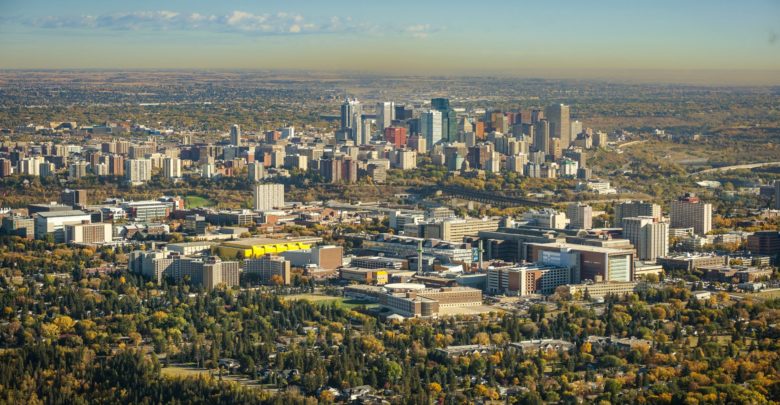Study finds U of A contributed $19.4 billion to Alberta’s economy last year
"I see the value of a U of A degree and what we're doing at the U of A only increasing," U of A president and vice-chancellor says.
 Richard Siemens
Richard SiemensAn economic impact study done by R.A. Malatest & Associates, found that the University of Alberta contributed $19.4 billion to Alberta’s economy in 2021-22. According to the study, this represents more than five per cent of provincial gross domestic product (GDP) — the total value in dollars of goods and services produced in Alberta — in 2021-22.
Five key areas were looked at: institutional spending, student spending, visitor spending, alumni education premium, and research impact. According to the study, because of the total contribution of $19.4 billion to Alberta’s economy through these key areas, “the U of A is a major economic engine for the province.”
Study finds a return of $4.80 for every dollar invested by provincial government
The study found that the Government of Alberta’s investment of $726.7 million in the U of A for 2021-22, resulted in a total economic impact of $3.5 billion. According to the study, this means that for every one dollar that the provincial government invested in the U of A, there was a return of $4.80.
In Budget 2023, the government announced that it will be funding $2.45 billion of the estimated $5.29 billion operating expense for post-secondary institutions. The funding from the government is an estimated increase of $15 million from the previous year.
On April 13, the provincial government announced that it will be investing $193 million toward targeted enrolment expansion in post-secondary programs across the province. Bill Flanagan, U of A president and vice-chancellor, said that targeted enrolment expansion impacts economic growth, as well as students.
“It’s an impact that touches everyone in the province by generating economic growth. Part of my pitch to the province is that we need to invest in enrolment growth, not only to provide opportunities to young Albertans, but because it’s the very best investment that the government can make,” Flanagan said.
Study explores economic impact of U of A’s research, alumni, and spending by the institution, visitors, and students
Out of the total $19.4 billion contributed to Alberta’s economy, research and development at the U of A contributed $8.2 billion, and it is deemed to directly and indirectly support increases in productivity.
Growth overtime in provincial GDP is due to increases in employment, capital, and productivity. According to the study, the research Impact was a “positive snowball effect over the years,” and knowledge and technology have led to increased productivity overtime.
“I was very impressed by this, because our research dollars are probably around $550 million a year,” Flanagan said. “A lot of the research activity that we do, not only spurs spin-off companies, patents, and commercialization of research, but it also generates gains in productivity which have a huge impact on GDP growth.”
The other major key area of economic impact is the alumni education premium, which contributed $5.1 billion directly, and $2.5 billion in indirect and induced growth. This resulted in a total contribution of $7.6 billion to the economy.
This impact is based on the estimated difference in wages between Alberta residents with a bachelor’s degree or higher and those with only a high school diploma or equivalent, multiplied with the number of U of A alumni. The study found that U of A alumni have a higher rate of productivity and direct spending in the province, because their wages tend to be higher.
“I know that with tuition and the cost of attending the U of A … this is all a huge investment,” Flanagan said. “I think this data really helps demonstrate that it’s probably the very best investment a person can make in their future.”
Flanagan added that because Canada’s economy is becoming a knowledge-based economy where knowledge and professional skills are at the core, the value of a U of A degree is increasing.
“Acquiring a university degree, I think, equips you with the skills to thrive in a knowledge-based economy. And this is increasingly where Canada’s economy is going. It’s the future. So I see the value of a U of A degree and what we’re doing at the U of A only increasing.”
“I see all of this continuing to grow as we grow,” U of A president and vice-chancellor says
The study found that institutional spending contributed $2.4 billion to the economy. Institutional spending includes spending on staff wages and salaries, maintenance and equipment, student services, and capital investments. Majority of wages and salaries paid were then spent in the province.
“We also purchase a lot of goods and services. We’re renovating our buildings, we’re constructing things, we’re buying supplies for research. Everything we do to run the university generates an additional billion dollars,” Flanagan said.
Student spending, which includes rent, food, and all other living expenses, had an impact of $745.4 million. Visitor spending, which includes those who traveled to Edmonton to visit students or attend conferences and events at the U of A, contributed $332 million to the economy.
Flanagan added that he thinks the U of A’s impact on Alberta’s economy will continue to increase in all areas because of more research funding, the movement into a knowledge-based economy, and enrolment growth.
“We want to grow our enrolment — we want to be well over 50,000 students — and that means more institutional spending. And more students means more students spending, more activity, and more visitors coming. So I see all of this continuing to grow as we grow.”




